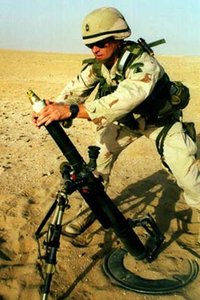Mortar (artillery)
|
|

A mortar is a smoothbore, muzzle-loading artillery piece that fires indirect shells (bombs in the UK) at low velocities, short ranges, and high-arcing ballistic trajectories. These attributes contrast with the mortar's larger siblings, rifled howitzers and field guns, which fire at higher velocities, longer ranges, and flatter arcs. Typically a modern mortar consists of a tube into which is dropped a mortar shell (bomb) onto a firing pin resulting in the detonation of the propellant and the firing of the shell.
In the 19th and early 20th centuries very heavy immobile siege mortars were used, of up to 1 m calibre.
A mortar can also be a launcher for fireworks, a hand-held or vehicle-mounted projector for smoke shells or flares, or a large grenade launcher.
Mortars are relatively simple and easy to operate artillery pieces. Light and medium mortars are man-portable, and are usually used by infantry organizations. The chief advantage a mortar section has over an artillery battery is its small size and its mobility. It is able to fire from the protection of a trench or defilade. In these aspects the mortar is an excellent infantry support weapon, as it can travel over any terrain and is not burdened by the logistical support needed for artillery.
There are also heavy mortars of 120 mm to 240 mm calibre. These are usually towed or vehicle-mounted weapons, sometimes breach-loaded, and normally employed by artillery units attached to battalion through division level. Even at this large size, mortars are simpler and less expensive than comparable howitzers or field guns.
A mortar can be carried by one or more people (larger mortars can be broken down into components), or transported in a vehicle. An infantry mortar can usually also be mounted and fired from a mortar-carrier; a purpose-built armoured vehicles with a large roof hatch. A heavy mortar can be mounted on a towed carriage, or permanently vehicle-mounted as a self-propelled mortar.
An unusual support weapon is the Soviet/Russian 2B9 Vasilek 82 mm automatic mortar. This is a fully-automatic weapon, capable of a high rate of fire. It can also be used in a direct fire mode, and can fire a HEAT round for use against light armoured vehicles.
| Contents |
Design
Modern mortars normally range in caliber from 60 millimeters (2.36 inches) to 120 millimeters (4.72 inches) however, aberrations both larger and smaller than these specifications have been produced. An example of the smaller scale is the British 51 mm light mortar which is carried by an individual and consists of only a tube and a base plate. Conversely, a large abnormality is the Soviet 2S4 M1975 "Tyulpan" (tulip tree) 240-mm self-propelled mortar. Aside from these though, most modern mortar systems consist of three main components: a tube, a base plate, and a bipod. These weapons are commonly used and transported by infantry based mortar sections as a substitute for, or in addition to, artillery.
81mm-mortar-rounds.png
Ammunition for mortar systems generally come in two main varieties: fin-stabilized and spin-stabilized. The former have short fins on their posterior portion that controls their path in flight. The latter use rotational spin (similar to a thrown American Football) to balance and control the mortar shell. These rounds can either be illumination, smoke, or high explosive.
History
Mortars have existed for hundreds of years, first finding usage in siege warfare. However, these weapons were huge heavy iron monstrosities that could not be easily transported. Simply made, these weapons were no more than an iron bowl truly reminiscent of the mortar wherefrom they drew their name. Portable mortars were first seen during the American Civil War and its resulting railroad mortars. However, it was not until World War I and the Stokes trench mortar devised by Sir Wilfred Stokes in 1915, that the modern, man-portable mortar was born. Extremely useful in the muddy trenches of Europe, mortars were praised because of their high angle of flight. A mortar round could be aimed to fall directly into trenches where artillery shells, due to their low angle of flight, could not possibly go. Modern mortars have improved upon these designs even more offering a weapon that is light, adaptable, easy to operate, and yet possesses enough firepower to provide the infantry with quality close support.
The largest mortars ever developed were "Mallet's mortar" (developed by Woolwich Arsenal, London in 1857) and the "Little David" (developed in the USA for use in World War II). Each weapon had a caliber of 36 inches (915 mm), neither were used in action.[1] (http://www.guinnessworldrecords.com/index.asp?id=46267)
See also
- List of artillery
- Category:Mortars
- Military technology and equipment
- Chemical mortar battalions of the United States Army
- Strix mortar round
External links
- Defense Update: Modern Mobile 120mm Mortars (http://www.defense-update.com/features/du-1-04/feature-mortars.htm)
- Defense Update: Advanced Mortar Munitions (http://www.defense-update.com/features/du-1-04/mortar-munitions.htm)
- Mortars during World War I (http://www.firstworldwar.com/weaponry/mortars.htm)
- The Karl Morser (http://www.aopt91.dsl.pipex.com/railgun/Content/Railwayguns/German/Morser%20karl.html), WWII-era German 60cm self-propelled mortar.da:Mortér
de:Mörser (Geschütz) he:מרגמה ja:迫撃砲 pl:Moździerz (broń) nl:Mortier (wapen)
